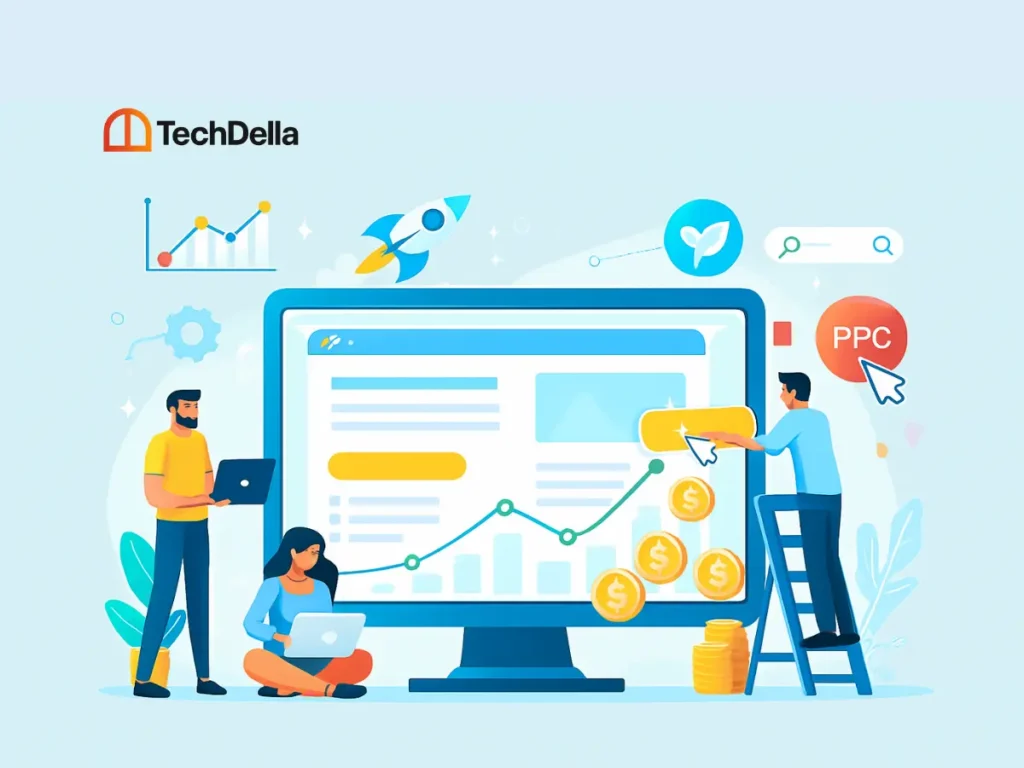
Landing pages are the unsung heroes of digital marketing. They’re where curiosity transforms into action, where clicks become customers, and where marketing dollars either multiply or vanish. Yet most businesses struggle to create SEO-friendly landing pages that perform well in both organic search rankings and paid advertising campaigns. The difference between a mediocre landing page and a high-converting one often comes down to understanding how SEO principles and conversion optimization work together.
Whether you’re a startup founder juggling a thousand priorities or a marketing professional trying to maximize ROI, this comprehensive guide will walk you through creating landing pages that don’t just look good; they deliver measurable results.

Understanding What Makes Landing Pages SEO-Friendly
SEO-friendly landing pages are more than attractive layouts with keywords added. They are strategic assets created to satisfy both search engines and real users. When technical structure works together with a strong user experience, these pages can rank well and turn traffic into measurable results. This balance depends on elements like fast loading times, mobile responsiveness, clear value messaging, and thoughtful keyword use.
Effective landing page optimization also relies on understanding what visitors want at each stage of their search. Whether users are gathering information, comparing options, or ready to purchase, your landing page design should guide them smoothly with content and structure that match their intent. When these parts come together, you build pages that feel helpful, perform well, and support real business growth.
Technical Elements That Make Landing Pages Rank
Creating conversion-focused landing pages begins with getting your technical SEO right. Search engines need to crawl, understand, and index your page before anyone can find it organically.
Start with page speed optimization: Google’s Core Web Vitals now directly impact rankings, and slow pages hemorrhage conversions. Compress images, minimize code, leverage browser caching, and consider a content delivery network. Tools like Google PageSpeed Insights show exactly where you’re losing speed.
Your URL structure matters more than you think: Keep URLs short, descriptive, and keyword-rich. Instead of “www.yoursite.com/page12345,” use “www.yoursite.com/seo-friendly-landing-pages.” Clean URLs improve both user trust and search engine comprehension.

Meta tags optimization is non-negotiable: Your title tag should include your primary keyword within the first 60 characters and compel clicks. Meta descriptions, while not direct ranking factors, significantly influence click-through rates from search results. Write them like mini advertisements that promise value.
Don’t overlook mobile-first indexing: Google predominantly uses the mobile version of your page for ranking. If your landing page doesn’t deliver a seamless mobile experience with touch-friendly buttons, readable text without zooming, and fast load times, you’re fighting an uphill battle for organic visibility.
Implement structured data markup (schema) to help search engines understand your content context. This can earn you rich snippets in search results, dramatically improving visibility and click-through rates.
Keyword Strategy: Balancing SEO and User Experience
Keyword research forms the backbone of SEO-friendly landing pages, but gone are the days of keyword stuffing. Modern SEO demands natural language that addresses user intent while incorporating relevant search terms.
Identify your primary keyword, like “SEO-friendly landing pages”, and naturally weave it into your headline, first paragraph, subheadings, and conclusion. Then support it with semantic keywords and related terms that Google associates with your topic: landing page optimization, conversion rate optimization, page speed optimization, mobile-friendly design, and user experience design.
Long-tail keywords often convert better because they capture specific intent. Someone searching “how to create landing pages for SaaS products” is further along their journey than someone just searching “landing pages.” Create content sections that address these specific queries.
At Techdella, we’ve helped numerous startups boost their organic visibility by 150% through strategic SEO content writing and landing page optimization. Our approach combines thorough keyword research with conversion-first design, ensuring pages rank well and turn visitors into customers.
For instance, we transformed a creative agency’s web presence, increasing qualified leads by 150% through full-stack SEO and conversion-optimized landing pages.
Content That Converts: Writing for Humans and Algorithms
The content on your high-converting landing pages must serve two masters: search engines and human visitors. The secret is creating genuinely helpful content that naturally incorporates SEO best practices.
Start with a compelling headline that addresses the visitor’s primary pain point or desire. Your value proposition should be immediately clear, within three seconds, visitors should understand what you offer and why it matters to them.
Structure your content with scannable formatting: short paragraphs, descriptive subheadings with keywords, bullet points for key benefits, and strategic white space. Most visitors scan rather than read every word, so make important information easy to spot.

Incorporate trust signals throughout: customer testimonials, case studies, industry certifications, security badges, and social proof. These elements boost conversions while providing valuable content that search engines can index and understand as credibility markers.
For PPC landing pages, maintain message match between your ad copy and landing page content. If your ad promises “affordable SEO services for startups,” your landing page headline should reinforce that exact promise. This consistency improves Quality Score in Google Ads, reducing cost-per-click while improving ad positions.
Call-to-action optimization can’t be overlooked. Your CTA should be specific, action-oriented, and appear multiple times on longer pages. “Get Your Free SEO Audit” converts better than generic “Submit” buttons.
Design and User Experience: Where SEO Meets Conversion
Beautiful design means nothing if it doesn’t convert. Landing page design must balance aesthetic appeal with functionality, load speed, and clear conversion paths.
Implement a clean, distraction-free layout that guides visitors toward your conversion goal. Every element should serve a purpose; if it doesn’t contribute to conversions or SEO, remove it. Excessive navigation menus, irrelevant images, or cluttered layouts increase bounce rates, which signals to Google that your page doesn’t satisfy user intent.
Visual hierarchy directs attention to your most important elements: headline, value proposition, benefits, social proof, and call-to-action. Use contrasting colors, strategic sizing, and positioning to create a natural flow through your content.
For businesses looking to create professional, mobile-first websites that convert, Techdella offers comprehensive web design and development services tailored for fast-moving startups. Our modern, SEO-ready websites are built to launch fast while maintaining the conversion-focused elements that turn traffic into revenue. We’ve helped founders like Johan Consults transform from word-of-mouth referrals to web powerhouse status, boosting client bookings by 3x through strategic content and optimized landing pages.
Optimize images with descriptive alt text that includes relevant keywords. This improves accessibility, helps search engines understand your visual content, and can drive traffic from image search results.
PPC-Specific Optimization: Maximizing Paid Campaign ROI
While organic SEO builds long-term value, PPC landing pages need additional optimization to maximize return on ad spend. The principles overlap, but paid campaigns demand even tighter focus on conversion efficiency.
Quality Score in Google Ads directly impacts your costs and ad positions. Three factors determine Quality Score: expected click-through rate, ad relevance, and landing page experience. Create dedicated landing pages for each ad group rather than sending all traffic to your homepage.

Remove navigation menus on PPC landing pages. You’ve paid for that click; don’t give visitors easy exit routes before they convert. Create a focused experience with a single conversion goal.
A/B testing becomes critical for paid campaigns where every click costs money. Test headlines, CTA button colors and copy, form lengths, images, and social proof placements. Small improvements in conversion rate dramatically impact campaign profitability.
Implement conversion tracking properly. Use Google Tag Manager to track not just form submissions but also micro-conversions: scroll depth, time on page, video views, and button clicks. This data informs optimization decisions and helps you understand user behavior.
Local SEO Considerations for Landing Pages
For businesses serving specific geographic areas, local SEO optimization adds another dimension to landing page creation. Include location-specific keywords naturally: “SEO services in Lagos” or “digital marketing agency in Dubai.”
Create separate landing pages for different service areas rather than trying to rank one page for multiple locations. Each page should include unique, locally-relevant content: local testimonials, area-specific case studies, and mentions of local landmarks or business districts.
Add your business name, address, and phone number (NAP) consistently across all landing pages. Embed Google Maps if you have a physical location. Register with Google Business Profile and other local directories, ensuring consistent NAP information everywhere your business appears online.
E-E-A-T: Building Authority and Trust
Google’s Search Quality Rater Guidelines emphasize Experience, Expertise, Authoritativeness, and Trustworthiness (E-E-A-T). Your landing pages should demonstrate these qualities through multiple signals.
Include author bylines with credentials for content-heavy landing pages. Link to authoritative sources when making claims. Display industry certifications, awards, and partnerships prominently. Maintain an updated, comprehensive “About Us” page that establishes your credentials.
Create original, valuable content based on real experience rather than repackaged generic information. Share specific case studies, data from your own research, and unique insights from your industry experience.
Techdella embodies these E-E-A-T principles through our transparent case studies showing 150% increases in qualified leads, our team’s documented startup marketing expertise, and our comprehensive, data-driven approach detailed at techdella. Our portfolio demonstrates real results for real clients across multiple industries and geographic markets.
Common Landing Page Mistakes to Avoid
Even seasoned marketers sabotage their landing pages with simple mistakes. Slow loading times push visitors away before they even read the content, while vague headlines fail to communicate any real value.
Long or complicated forms add unnecessary friction, and unclear calls to action leave users unsure of what to do next. Mobile users are often ignored, even though most searches happen on smaller screens, which means a poorly optimized layout can cost you most of your potential conversions.
Another common issue is inconsistent messaging between ads and landing pages. When the promise in the ad does not match what users see after clicking, Quality Score drops, and ad spend gets wasted. Keeping your message consistent from the first click through to the follow-up improves trust, relevance, and conversion performance.
Frequently Asked Questions
What’s the ideal length for SEO-friendly landing pages?
There’s no universal answer; length depends on your goal and audience. For simple conversions like newsletter signups, short pages (300-500 words) work well. For complex B2B solutions or high-ticket items, longer pages (1,500-3,000 words) that thoroughly address objections and questions convert better.
Should I use the same landing page for organic SEO and PPC campaigns?
Generally, no. While the core message should align, PPC landing pages benefit from focused, distraction-free designs with removed navigation and singular CTAs. SEO landing pages need more comprehensive content, internal linking, and additional navigation to support broader organic discovery.
How long does it take for landing pages to rank organically?
New landing pages typically take 3-6 months to achieve meaningful organic rankings, though this varies significantly based on competition, domain authority, backlink profile, and content quality. You can accelerate results through strategic internal linking, building quality backlinks, promoting content through social channels, and consistently updating pages with fresh, relevant content.
Conclusion
Creating high-performing SEO landing pages takes specialized skills in technical optimization, design, copywriting, and analytics, which can be costly for growing businesses to build internally. Techdella streamlines this by delivering conversion-focused pages that rank well and boost ROI. Our blend of strategic SEO, clear messaging, and data-driven refinement has led to major wins, including substantial jumps in qualified leads and client bookings.
If you are launching a product or trying to lift conversion rates, Techdella acts as your growth partner, moving quickly and improving based on real results rather than assumptions. Want landing pages that actually convert? Book a free discovery call with Techdella and see how our approach can upgrade your digital marketing performance.




